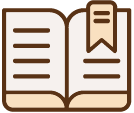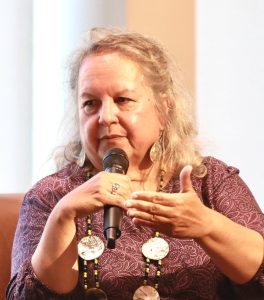4.1 Strategy 1: Adjusting Our Language When Seeking Diverse Knowledge
In the previous chapters, we saw that many voices are missing or excluded from search engine results and academic conversations. We also identified how our dominant knowledge systems –whether library catalogues or Google– privilege the written word. Similarly, colonial languages like English are expected to be the default, especially in academic conversations (Arenas-Castro, 2025).
So, how do we find diverse voices? One important factor is reconsidering the language we choose to use when searching. Like epistemology, language is shaped by culture. Words and grammar reflect our values, worldviews, laws, and identities, sometimes in ways that we don’t even realize.
Consider watching the video below of Dr. Robin Wall Kimmerer, member of the Citizen Potawatomi Nation and a SUNY Distinguished Teaching Professor of Environmental Biology. In the video, Dr. Kimmerer reflects on how ![]() the English word “it” embodies Eurowestern values about the natural world and the superiority of humans over other living beings like animals, plants, and water.
the English word “it” embodies Eurowestern values about the natural world and the superiority of humans over other living beings like animals, plants, and water.
When we seek out diverse perspectives using a knowledge justice lens, it is important to ask: What language does the community use to describe themselves or their knowledge? If we only use the terms we’ve been taught in school or see in the media, we may unintentionally leave out the very voices we’re trying to include.
Consider, for example, the use of hashtags on social media. Hashtags are often created by communities themselves and reflect how people want to be seen and understood. The hashtag #ActuallyAutistic emerged from within the autistic community ![]() as a way to reclaim the conversation around autism (Boren, 2024). Self-chosen terms like hashtags can be quite different from the more formal, controlled language sometimes used in library databases, government websites, or news media. They also tend to evolve over time, aligning with shifts in community-preferred language.
as a way to reclaim the conversation around autism (Boren, 2024). Self-chosen terms like hashtags can be quite different from the more formal, controlled language sometimes used in library databases, government websites, or news media. They also tend to evolve over time, aligning with shifts in community-preferred language.
Reflecting on Harmful Terminology
It’s important to acknowledge that, when seeking out new knowledge, we can come across language that is upsetting, prejudiced, or outdated (Western Libraries, 2025 ). We recognize that just because a term appears in a ‘credible’ source like a scholarly database , it does not mean it’s appropriate. Often standardarized metadata terminologies can be harmful or problematic ![]()
But we must be aware that it is common for large institutions to lag behind social convention and continue to use outdated or even harmful terminology. Large organizations like government agencies are often responsible for the creation of many policies, resources, and other documents that take time to be revised using up-to-date language. They are sometimes beholden to changing political climates or funding restrictions.
As a result, sometimes we still must search using outdated terminology in order to find certain sources or critique dominant systems. Consider the following example about the term “Indian” from Cree-Métis librarian Jessie Loyer.
@indigenouslibrarian using the term “Indian” in research
When applying Strategy 1 to find diverse voices, we need to ensure the terminology and search terms we use represent multiple worldviews, communities, and social identities. We can use the prompt questions below as the first step of applying Strategy 1, to identify a list of terminology to use when searching that will help you find a range of worldviews and perspectives
- What does the community call themselves? What words do they use to describe your topic?
- What terminology do libraries / databases use? (see the section below on using library databases)
- What terminology or phrases does your discipline / profession / field use?
- What terms do governments use?
- What terminology or phrasing has been used in the past?
- What terminology or phrasing is considered harmful, out-of-date, or is considered a ‘red flag’?
When thinking about language, remember that you matter, too! It can be distressing to encounter harmful terminology. It’s okay to acknowledge that and take a break when you need it.
Ultimately, using a knowledge justice lens means choosing search terms thoughtfully. Some terms will help you find one group’s perspective while hiding another’s. The goal isn’t to find the ‘perfect’ set of terms – it’s to be flexible, reflective, and respectful in your search. Keep asking: Whose voices am I finding – and whose might still be missing?
Applying Strategy 1: Finding Diverse Search Terms
Let’s apply our understanding of terminology to the case study from Chapter 3.
 Activity: Apply Strategy 1
Activity: Apply Strategy 1
Review your reflection responses, too: what support need did you choose at the end of Chapter 3? Which experts or authorities did you identify whose perspectives we should now seek out?
Next, think about the language the different ‘experts’ you identified might use to describe this case. We will need this terminology to find diverse perspectives so we can better understand our clients, or have evidence to make a decision.
Using the questions for this strategy, try to brainstorm a list of search terms you might use to find the voices needed for the case:
- What does the community call themselves? What words do they use to describe your topic?
- What terminology do libraries / databases use? (see the section below on using library databases)
- What terminology or phrases does your discipline / profession / field use?
- What terms do governments use?
- What terminology or phrasing has been used in the past?
- What terminology or phrasing is considered harmful, out-of-date, or is considered a ‘red flag’?
All activities can also be found in a downloadable workbook. Visit the ‘Using this Resource‘ page to access the workbook in MS Word and PDF formats.
It will likely be easy to find terminology used by governments, libraries, and academics, because they tend to use more formalized structures. For cultural, niche, community-based, or other colloquial language, you may need to do a bit more digging to answer these questions.
To find a community term, such as a hashtag, consider exploring social media sites or searching in Google ![]() or DuckDuckGo
or DuckDuckGo ![]() , to see how other people in the community are using it. You might find blog posts, forum threads, posts, or opinion pieces that offer insight into why some people use the term and others don’t.
, to see how other people in the community are using it. You might find blog posts, forum threads, posts, or opinion pieces that offer insight into why some people use the term and others don’t.
The following resources are available to help you identify inclusive and diverse search terms, like:
- Western University The Diversity & Inclusion Glossary

- Homosaurus
 – A vocabulary of Lesbian, Gay, Bisexual, Transgender, and Queer (LGBTQ+) terms
– A vocabulary of Lesbian, Gay, Bisexual, Transgender, and Queer (LGBTQ+) terms - Stimpunks Foundation Glossary: Develop a Language in Which We Can Both Understand and Challenge the World

Demonstration of Strategy 1 for Case Study
Watch the video below to hear how your chapter authors found search terms. Recall that we’re using the issue of safe infant sleep as our search example, so your own list of terms might look very different if you focused on a different support need for this case.
In your workbook, you’ll also see a document with a chart mapping out our search process. Be sure to follow along!
A branch of philosophy that studies knowledge and belief. Within the context of knowledge justice, epistemology is often used to describe a person’s worldview, theory of knowledge, or way of knowing.


